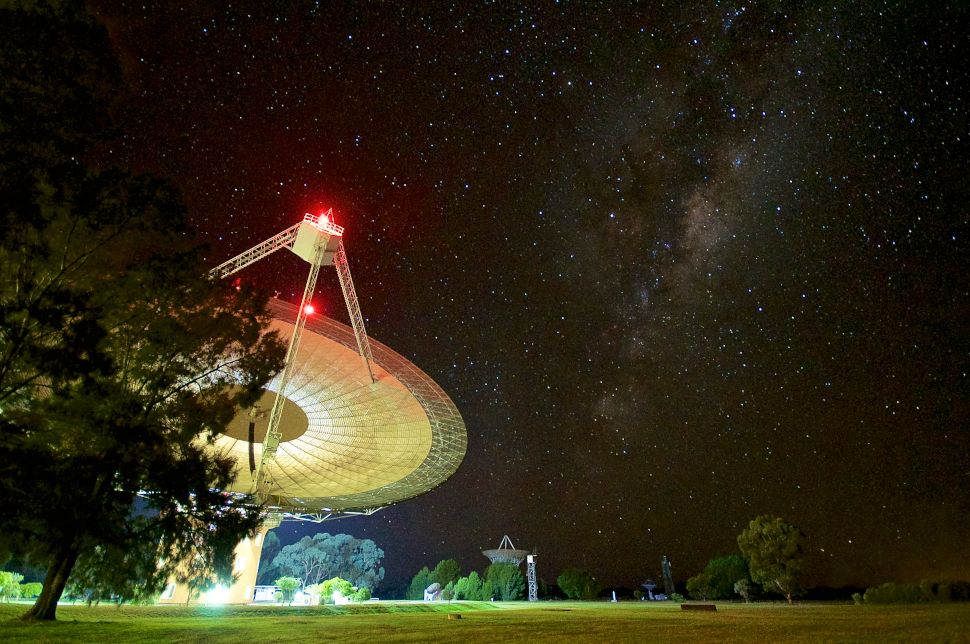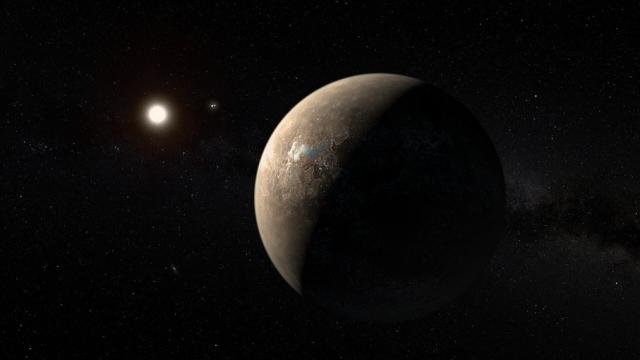Researchers with the Breakthrough Listen project have detected a curious signal originating from Proxima Centauri, the nearest star to the Sun. The signal has been designated as a possible alien transmission, but like so many examples in the past, this latest detection is probably another dead end.
Scientists with the $US100 ($132) million Breakthrough Listen project, funded by Israeli-Russian billionaire Yuri Milner, are currently working on a research paper describing this signal, but news of the detection somehow leaked to The Guardian last week. With the cat comfortably out of the bag, details about the strange signal are now emerging, but the supporting data remains unavailable.
Here’s what we know.
The narrowband radio signal, found at 982.001 MHz, was picked up by the 64.01 m radio telescope at the Parkes Observatory in Australia, as Scientific American reports. The emission appeared to originate from Proxima Centauri, a red dwarf located 4.2 light-years away. The system hosts two known exoplanets, one of which, Proxima Centauri b, resides inside the habitable zone. Interestingly, the frequency of the signal drifted ever so slightly. This could be a Doppler shift caused by movement of the source, such as an orbiting exoplanet.
The Breakthrough Listen team, led by Andrew Siemion from the University of California at Berkeley, wasn’t looking for aliens at the time. Rather, they were looking for signs of flares coming from the red dwarf, as these bursts could detrimentally affect habitability in the Proxima Centauri system. This data was gathered in April and May 2019, but the signal wasn’t spotted until recently. Shane Smith, an undergrad at Hillside College in Michigan and an intern with Berkeley’s SETI project, found the signal while performing a routine review of the 30 hours’ worth of data, according to SciAm (imagine if it turns out to be aliens — Smith would instantly become the most legendary intern in history).

The emission appears to be a one-off event, appearing only once in the dataset. With no obvious source for the signal, the team labelled it BLC-1, meaning Breakthrough Listen Candidate 1. This is the first official candidate signal for the 10-year project, which launched in 2015. Astrophysicist Sofia Sheikh from Penn State University will be the lead author of the upcoming paper, which is expected in early 2021, as SciAm reports.
A very slim chance exists that the signal was produced by extraterrestrial intelligence, whether it be incidental radio leakage or a targeted transmission designed to catch our attention (i.e., a possible technosignature). Indeed, the Breakthrough Listen researchers themselves fully expect BLC-1 to not be aliens. As Pete Worden, the executive director of the Breakthrough Initiatives, told SciAm, “it’s like 99.9%” not aliens.
[referenced id=”1659010″ url=”https://gizmodo.com.au/2020/12/discoveries-that-really-really-seemed-like-aliens/” thumb=”https://gizmodo.com.au/wp-content/uploads/2020/12/17/t671o5t7vjn3khaflj0f-300×169.jpg” title=”Discoveries That Really, Really Seemed Like Aliens” excerpt=”As the famous X-Files poster declares, “I want to believe.” This wanting, however, often leads us astray. When confronted with shocking and inexplicable celestial phenomena, we tend to see intelligent design. This jumping to conclusions is a sin for which we can be forgiven — we have an insatiable need…”]
Importantly, terrestrial interference, like a microwave oven or some other distraction, has not yet been ruled out as a possible source of the radio emission. BLC-1 brings the 1974 WOW! signal to mind, which likewise failed to repeat, making it difficult for scientists to study (recent research suggests it came from a hydrogen cloud caused by comets).
That BLC-1 came from aliens is unlikely for a number of reasons.
First of all, BLC-1 appears to be an unmodulated signal. It’s a boring, unchanging tone. If aliens were trying to contact us, surely they’d make the message a bit more interesting, like transmitting a sequence of attention-grabbing prime numbers, as portrayed in Carl Sagan’s Contact. The unmodulated nature of the signal also makes it a poor candidate for incidental radio leakage.
Also, space is absolutely filled with all sorts of natural radio signals. A natural source for BLC-1 is not immediately obvious, but scientists will have to rule out things like our Sun, Jupiter, neutron stars and pulsars, supernova remnants, radio galaxies, and so on.
Terrestrial sources will also have to be ruled out, along with orbiting satellites, as Seth Shostak, senior scientist with the SETI Institute, explained in a recent post:
Indeed, it just might be a telemetry signal from an orbiting satellite. The orbital motion of these satellites cause their transmissions to rise and fall in frequency, after all. And while you might think that the chances of accidentally tuning in a satellite are not great, you should think again. There are more than 2,700 functioning satellites buzzing our planet, providing information on the weather, imagery for Google Earth, GPS signals for navigation, and high-resolution photos for the military, just to name a few. This flood of information from hardware a few hundred miles above our heads is obviously important for a high-tech lifestyle, but it jams a lot of the radio spectrum. SETI scientists are trying to find a needle in a pile of pins.
It’s also important to point out that the Proxima Centauri system is a very poor candidate for extraterrestrial life, given that the star is a red dwarf. As research shows, red dwarfs are subject to frequent and powerful solar flares, making it difficult for life to emerge and evolve around them. The exoplanet Proxima Centauri b is so close to its host star that it takes just 11 days to complete a single orbit.
And then there’s the whole implausibility of it all. The odds that Proxima Centauri — the closest star to our solar system — hosts an intelligent civilisation is so grossly improbable that I lack the proper adjectives to describe just how grossly improbable it is. If our nearest neighbour is inhabited by aliens, and at precisely the same time that we’re around, that means the rest of the galaxy must be teeming with life. We cannot accept this conclusion, however, given the Great Silence and the Fermi Paradox. Indeed, if life is ubiquitous in both time and space, we should’ve seen signs of aliens by now (more on this subject here, here, here, and here).
This is not to say the Breakthrough Listen team is wrong to consider aliens as a possible source of BLC-1. They’re absolutely right to do so, as no good explanation yet exists to explain the strange emission. Moving forward, radio astronomers should train their telescopes on Proxima Centauri in hopes of a repeat, while other scientists should investigate possible sources of the strange signal. We’ll just have to remain patient and not jump to conclusions, as is our tendency.
